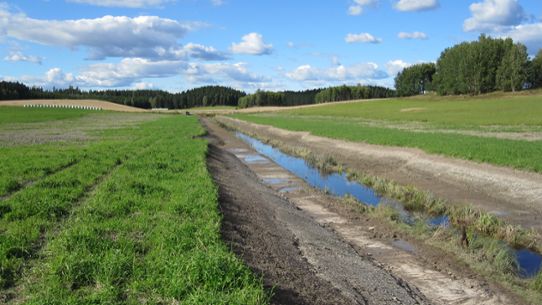The first two-stage ditch in Sweden was dug in summer 2012 on arable land just outside of Nyköping in Södermanland. This was to prevent flooding and erosion of cultivable arable land. The majority of plants can survive a dry period, but not a long wet period. The roots suffer from oxygen deprivation and the crop dies.
Two-stage ditch
A two-stage ditch involves retaining the original furrow, but the edges of the ditch are dug out and the ditch is widened. When there are large water flows, the water rises and overflows the upper flooding stage instead of overflowing onto the field. The vegetation on the flooding stage stabilises the land by the water and prevents soil particles being washed away downstream by the water.

The two-stage ditch was dug in summer 2012 in the 800 metre-long ditch in the arable land and was a trial as part of a larger project. The earth removed was distributed on low-lying parts of the adjacent field. The two-stage ditch has taken up a total of 1 hectare of arable land.
Digging out the steeper ditch edges results in a more certain use of the land. Erosion of the ditch edges is reduced, as is the risk of flooding on the agricultural land. Cereals that are sensitive to flooding are now grown on this land instead of it being used for pasture as in the past, which is leading to a higher return.
Financing
The two-stage ditch in Åkra is the first two-stage ditch dug in Sweden and is acting as a trial ditch. The project was therefore financed by the county administrative board though the Svärtaå Project. The project had a total cost of almost SEK 218 600. This cost includes such things as permit applications and excavation. A great deal of voluntary work on the part of the landowner was required.
More examples of climate adaptation
This is one of many examples of climate adaptation. There are more in the collection of ideas being built up by the Swedish National Knowledge Centre for Climate Change Adaptation at the Swedish Meteorological and Hydrological Institute (SMHI). The collection of examples has the aim of sharing experiences and providing ideas to everyone who works with climate adaptation. Examples describe concrete measures and challenges in several subject areas. They show how different actors have worked to adapt their activities to the climate changes that are already being noticed today and those that we cannot prevent in the future.